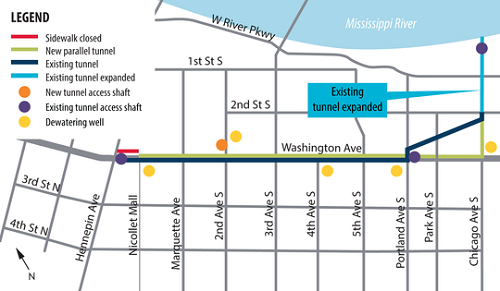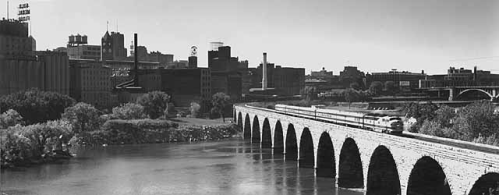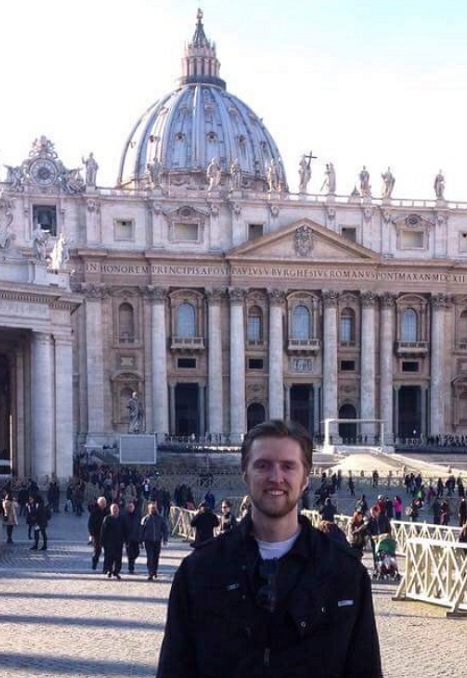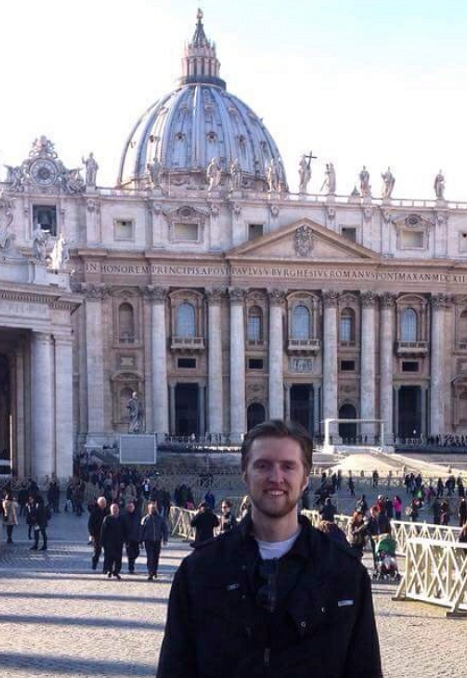Minneapolis Central City Tunnel Project Update
 Tuesday, February 8, 2022 at 4:03AM |
Tuesday, February 8, 2022 at 4:03AM |  Kim Eslinger |
Kim Eslinger | Via a February 7 e-announcement from the City of Minneapolis:

The City of Minneapolis Public Works Department is constructing a new parallel storm tunnel, enlarging a portion of the existing storm tunnel, and constructing a new tunnel access in Downtown Minneapolis. This project is anticipated to be completed summer 2023.
The new tunnel is being constructed parallel to the existing tunnel located under Washington Ave S between Nicollet Mall and Chicago Ave. The existing tunnel under Chicago Ave between Washington Ave S and the Mississippi River is being expanded to handle the increased stormwater capacity. The purpose of this project is to reduce pressure in the existing tunnel, provide more room for future growth, and to reduce the need for future repairs and tunnel failures.
Project Map

Latest Project News
Hennepin Ave
- Tunneling the new parallel storm tunnel under Washington Avenue continues. You will see crews continue excavating soils from the existing tunnel access shaft at the northeast corner of the Washington Ave and Hennepin Ave intersection. This is to begin tunneling the new parallel storm tunnel under Washington Avenue.
- There may be short, periodic delays while crews move equipment and materials around.
Chicago Ave
- Crews are setting up the dewatering well and pumps on the northeast corner of the Washington Ave and Chicago Ave intersection. This work is anticipated to be completed by mid-to-late February.
- There will be no lane closures needed to complete this work.
- There may be short, periodic delays while crews move equipment and materials around.
Nicollet Mall
- Crews continue setting up the dewatering well and pumps near the southeast corner of the Nicollet Mall and Washington Ave intersection. This work is anticipated to be completed by February 7th.
- The eastern sidewalk along Nicollet Mall between Washington Ave and 3rd St N is closed. Access is open to the Marquette Plaza building.
- Pedestrians are still able to use the sidewalk on the west side of Nicollet Mall.
- The crosswalk at the Washington Ave intersection remains open.
2nd Ave
- Crews continue installing the new tunnel access shaft in the southbound lanes of 2nd Ave S, just north of the Washington Ave intersection. Crews continue drilling, excavating, and installing the shaft walls. Drilling work is anticipated to be completed by February 7th and the drilling equipment will be hauled out the week of February 14. Equipment for the excavation of the tunnel will be brought in the week of February 21.
- The sidewalks remain open on both sides of the road.
- The crosswalk at the Washington Ave and 2nd Ave S intersection remains open.
- 2nd Ave S remains a single lane in each direction using the northbound lanes between Washington Ave and 1st St S until the project is completed in 2023.
- Access to driveways off 2nd Ave S remain open. There may be short-term access delays while crews move equipment and materials around.
4th Ave
- The dewatering well is anticipated to be completely set up and running the week of February 7. The east lane of 4th Ave S between 3rd St S and Washington Ave will open to traffic by Friday, February 11, or after the dewatering well is running.
- The sidewalk on the east side of 4th Ave S remains closed.
- Pedestrians can use the sidewalk on the west side of 4th Ave S.
- The crosswalk at the Washington Ave and 4th Ave intersection remains open.
- Access to driveways off 4th Ave S remains open.
Portland Ave
- The dewatering well is anticipated to be completely setup and running by the first week of February. The west parking lane of Portland Ave between 3rd St S and Washington Ave will open to traffic by Friday, February 11.
- The west sidewalk will be restricted to pedestrians around the dewatering well and pumps.
Mississippi River Portal
- Crews continue excavating soils above the storm sewer tunnel and grouting near the existing retaining wall at the Mississippi River portal site. Crews will continue stabilizing the slope through February.
- The parking lot off Portland Ave east of the Stone Arch Bridge, near Mill Ruins Park, is temporarily closed for the winter and will reopen spring 2022. This closure is necessary to complete the work in this area safely and efficiently.
- The parking lot near Portland Ave and W River Pkwy remains open.
What to Expect
- Expect additional noise, dust, and vibration as crews complete work.
- Schedule is tentative and subject to change due to weather and other unforeseen circumstances.
Long-term closures/restrictions
- The north westbound lane, bike lane, and parking lane will be closed on Washington Avenue between Portland Ave and Park Ave. These closures will remain in place through spring 2022. This is necessary for the contractor to utilize the existing shaft to connect the existing tunnel to the new tunnel.
- During this closure, pedestrians can still use the sidewalks along Washington.
- Crosswalks across Washington Ave and Portland Ave will remain open.
- Bicyclists will share the traffic lane.
- The existing left turn lane on Washington Ave at the Portland Ave intersection will temporarily become a left turn and through lane.
- The north sidewalk along Washington Ave remains closed between Hennepin Ave and Nicollet Mall through spring 2022. The contractor is utilizing an existing shaft in this area to connect the existing tunnel to the new tunnel.
- During this closure, pedestrians share the bike lane on Washington Ave.
- The crosswalks at the Washington Ave intersections of Nicollet Mall and Hennepin Ave remains open.
Stay Connected
There are multiple ways to get information including email updates and ongoing stakeholder meetings. Visit the project website for more information and to sign up for project updates: https://www.minneapolismn.gov/government/projects/central-city-tunnel/
Email the project team: info@mplscentralcitytunnel.com
Contact the project hotline: 612-888-9418

































